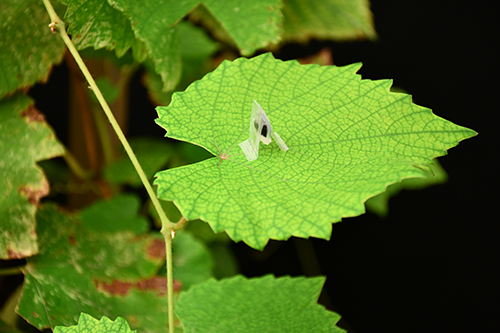The research group coordinated by Barbara Mazzolai at the IIT – Istituto Italiano di Tecnologia (Italian Institute of Technology) has created the first ever prototype of a soft, biodegradable and soluble velcro inspired by the micro-hook structure of leaves on the “catchweed” plant (Galium aparine), for use in devices for the monitoring and safeguarding of the environment and in precision farming.

Microhooks-based MiniBot over a V. lambrusca leaf. Inset: the interlocking mechanism enabled by the microhooks printed on the feet of the light-driven, low-weight MiniBot. When the 808 nm laser hits the actuator, the actuator expands and the microhooks on the back foot create friction with the leaf surface. At the same time, the hooks on the front foot slide off enabling the demonstrator to move forward, and blocking backward motion. During the laser-off phase, when the fluidic actuator cools down it shrinks. The microhooks of the front foot then interlock and/or create sufficient friction to remain in the position obtained during expansion of the actuator, whereas the hooks on the back foot slide forwards, enabling on-leaf mobility of the robot.
The research, published in the international journal Communications Materials ("Plant-like hooked miniature machines for on-leaf sensing and delivery"), shows how the artificial micro-hooks can be applied to a series of devices that, when attached to plant leaves, act as a kind of temporary plaster, releasing beneficial substances into the plant’s vascular system, or as intelligent clips that wirelessly communicate information on the health status of crop plants.
The research has been funded with the support of the National Geographic Society, and as part of the European-funded project GrowBot, dedicated to the creation of new robots inspired by climbing plants and for which Mazzolai is coordinator.
The climbing plant Galium aparine, commonly known as “catchweed”, has evolved a particular mechanism for parasitic anchoring that allows it to climb over other plants via micro-hooks on its leaves. These hooks allow it to anchor onto the surfaces of other plants as it grows, exploiting them for physical support.
The researchers at IIT studied the structure of these natural micro-hooks from both a morphological and biomechanical point of view in order to artificially reproduce their characteristics. The hooks were made with a high-resolution 3D printer, employing a range of highly resistant materials and with characteristics that can be adapted to the relative application, for example to photosensitive or biodegradable materials made from isomalt, a sugar-like substance.
“Our studies always begin by observing nature, seeking to replicate the strategies employed by living creatures through low-environmental-impact robotic technologies”, commented Barbara Mazzolai, Associate Director of Robotics at IIT and the head of the IIT Bioinspired Soft Robotics Lab. “With this latest research project, we have further demonstrated that it is possible to create innovative solutions that not only have the aim of monitoring the health of our planet, in particular of plants, but of doing so without altering it”.
The micro-hook structure has been tested for its anchoring capacities and has proved to be capable of solidly attaching to a range of plant species. On the basis of this form of velcro, the researchers have come up with a number of devices to use in precision farming and in environmental protection.
One initial application has been designed to penetrate plant cuticle in a barely invasive manner, allowing plants to be monitored and treated. By attaching to the plant, the isomalt micro-hooks can connect with the leaf’s vascular system and, as isomalt is soluble, dissolve inside. This application allows the micro-hooks to be used as a plaster that can locally release beneficial substances, pharmaceuticals, pesticides or bactericides onto the leaves, optimising the use of natural resources and reducing the excessive use of pesticides, thus contributing to the protection of ecosystems. Furthermore, once applied, the plaster dissolves, thus avoiding the creation of waste.
“These micro-hooks are versatile and have allowed us to create a range of applications, as well as filing a patent”, explained Isabella Fiorello, a researcher in Mazzolai’s group at the Genoa-based IIT, and the main author of the project. “This form of anchoring can be exploited for in situ monitoring of the plant’s microclimate, such as temperature, humidity and light, or for the controlled release of molecules into the plant’s vascular system”.
In particular, hooks printed with the use of a photosensitive resin have been assembled together with electronics and sensors for light, temperature and humidity within a unified system, creating intelligent clips for the wireless monitoring of the plant through both sides of the leaf. Lastly, again on the basis of the same structure, the researchers have come up with a microrobotic system capable of using microsteps to move over the surface of the leaves.
If there is infringement, please contact us to delete.
Information Publisher: Isabella Fiorello et.al
Information Release Unit: Italian Institute of Technology
Information Source: https://www.nature.com/articles/s43246-021-00208-0

